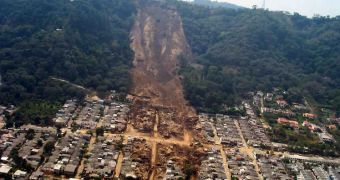Researchers in the United Kingdom announce the development of a new method of surveying dangerous geological areas for risks of impending landslides. The technique relies of sound interpretation to give early warnings of the looming threat.
The electronic ear can listen for the subtle noises that ground layers make as the pass atop each other, which can provide indications as to the stability of the terrain in a particular area.
The theoretical background on which the new system is built is nothing new, as researchers have known for some time that acoustics can give hints on the state of hills and other disaster prone landscape features.
But what was lacking until now was a technique to quantify the noises, and to attach a threat level to them. This is precisely what the team, based at the Loughborough University in England, did recently.
The researchers there developed their own sound system to analyze layers of shifting soils, which can accurately link the acoustical signals these events produce with ground displacement rates.
“We developed a calibrated system. So if we get a certain amount of acoustics, we can say how fast the slope is moving,” explains LU professor of geotechnical engineering Neil Dixon, who was the leader of the new study.
An added advantage the new system has over all others is that it can produce these readings in real time and from a distance, without research teams having to travel to the dangerous area for direct studies.
Working together with colleagues at the British Geological Survey (BGS), the investigators devised a fairly simple method of analyzing the noises the ground makes.
The technique involves drilling boreholes into hillsides, and inserting long steel tubes inside. The holes can reach depth of up to several hundred feet, depending on the geology of the region.
The main idea here is to penetrate the ground until the most unstable layers of the hill are reached. After this is done, the tubes are surrounded with a layer of gravel. As the ground moves, the gravel makes noises that can be picked up and deciphered with specialized software.
“The beauty of this is it uses cheap gravel, [and] so you can use local materials,” says Dixon, adding that virtually all types of gravel can be used in the new system, following proper calibration.
The team leader already envisions a future in which the new system is deployed on hills overlooking villages , or maybe even large cities.
“Even if it only gave a warning of tens of minutes, still you could evacuate people,” Dixon concludes, quoted by Our Amazing Planet.

 14 DAY TRIAL //
14 DAY TRIAL //